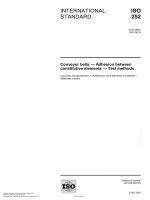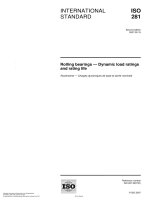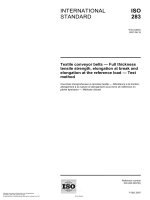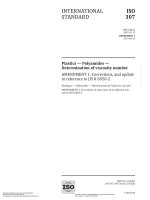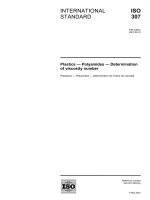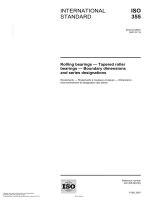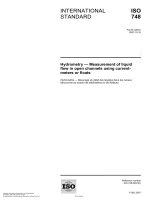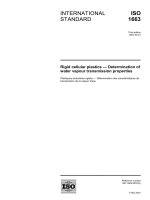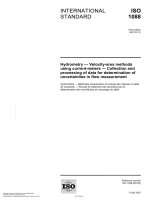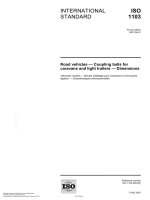Tiêu chuẩn iso 15529 2007
Bạn đang xem bản rút gọn của tài liệu. Xem và tải ngay bản đầy đủ của tài liệu tại đây (551.96 KB, 32 trang )
INTERNATIONAL
STANDARD
ISO
15529
Second edition
2007-09-15
Optics and photonics — Optical transfer
function — Principles of measurement of
modulation transfer function (MTF) of
sampled imaging systems
Optique et photonique — Fonction de transfert optique — Principes de
mesure de la fonction de transfert de modulation (MTF) des systèmes
de formation d'image échantillonnés
Reference number
ISO 15529:2007(E)
--`,,```,,,,````-`-`,,`,,`,`,,`---
Copyright International Organization for Standardization
Provided by IHS under license with ISO
No reproduction or networking permitted without license from IHS
Not for Resale
© ISO 2007
ISO 15529:2007(E)
--`,,```,,,,````-`-`,,`,,`,`,,`---
PDF disclaimer
This PDF file may contain embedded typefaces. In accordance with Adobe's licensing policy, this file may be printed or viewed but
shall not be edited unless the typefaces which are embedded are licensed to and installed on the computer performing the editing. In
downloading this file, parties accept therein the responsibility of not infringing Adobe's licensing policy. The ISO Central Secretariat
accepts no liability in this area.
Adobe is a trademark of Adobe Systems Incorporated.
Details of the software products used to create this PDF file can be found in the General Info relative to the file; the PDF-creation
parameters were optimized for printing. Every care has been taken to ensure that the file is suitable for use by ISO member bodies. In
the unlikely event that a problem relating to it is found, please inform the Central Secretariat at the address given below.
COPYRIGHT PROTECTED DOCUMENT
© ISO 2007
All rights reserved. Unless otherwise specified, no part of this publication may be reproduced or utilized in any form or by any means,
electronic or mechanical, including photocopying and microfilm, without permission in writing from either ISO at the address below or
ISO's member body in the country of the requester.
ISO copyright office
Case postale 56 • CH-1211 Geneva 20
Tel. + 41 22 749 01 11
Fax + 41 22 749 09 47
Web www.iso.org
Published in Switzerland
ii
Copyright International Organization for Standardization
Provided by IHS under license with ISO
No reproduction or networking permitted without license from IHS
© ISO 2007 – All rights reserved
Not for Resale
ISO 15529:2007(E)
Contents
Page
Foreword............................................................................................................................................................ iv
Introduction ........................................................................................................................................................ v
1
Scope ..................................................................................................................................................... 1
2
Normative references ........................................................................................................................... 1
3
3.1
3.2
Terms and definitions and symbols ................................................................................................... 1
Terms and definitions........................................................................................................................... 1
Symbols ................................................................................................................................................. 4
4
4.1
4.2
4.3
Theoretical relationships ..................................................................................................................... 4
Fourier transform of the image of a (static) slit object ..................................................................... 4
Fourier transform of the output from a single sampling aperture for a slit object scanned
across the aperture............................................................................................................................... 6
Fourier transform of the average LSF for different positions of the object slit ............................. 7
5
5.1
5.2
5.3
5.4
Methods of measuring the MTFs associated with sampled imaging systems............................... 8
General................................................................................................................................................... 8
Test azimuth .......................................................................................................................................... 8
Measurement of Tsys of a sampled imaging device or complete system........................................ 9
Measurement of the MTF of the sampling aperture (Tap)................................................................ 15
6
Method of measuring the aliasing function, the aliasing ratio and the aliasing potential .......... 15
Annex A (informative) Background theory ..................................................................................................... 17
Annex B (informative) Aliasing in sampled imaging systems ..................................................................... 20
Bibliography ..................................................................................................................................................... 25
--`,,```,,,,````-`-`,,`,,`,`,,`---
iii
© ISO 2007 – All rights reserved
Copyright International Organization for Standardization
Provided by IHS under license with ISO
No reproduction or networking permitted without license from IHS
Not for Resale
ISO 15529:2007(E)
Foreword
ISO (the International Organization for Standardization) is a worldwide federation of national standards bodies
(ISO member bodies). The work of preparing International Standards is normally carried out through ISO
technical committees. Each member body interested in a subject for which a technical committee has been
established has the right to be represented on that committee. International organizations, governmental and
non-governmental, in liaison with ISO, also take part in the work. ISO collaborates closely with the
International Electrotechnical Commission (IEC) on all matters of electrotechnical standardization.
International Standards are drafted in accordance with the rules given in the ISO/IEC Directives, Part 2.
The main task of technical committees is to prepare International Standards. Draft International Standards
adopted by the technical committees are circulated to the member bodies for voting. Publication as an
International Standard requires approval by at least 75 % of the member bodies casting a vote.
Attention is drawn to the possibility that some of the elements of this document may be the subject of patent
rights. ISO shall not be held responsible for identifying any or all such patent rights.
ISO 15529 was prepared by Technical Committee ISO/TC 172, Optics and photonics, Subcommittee SC 1,
Fundamental standards.
This second edition cancels and replaces the first edition (ISO 15529:1999) which has been technically
revised to include measurement and test procedures for aliasing of sampled imaging systems.
iv
--`,,```,,,,````-`-`,,`,,`,`,,`---
Copyright International Organization for Standardization
Provided by IHS under license with ISO
No reproduction or networking permitted without license from IHS
© ISO 2007 – All rights reserved
Not for Resale
ISO 15529:2007(E)
Introduction
One of the most important criteria for describing the performance of an imaging system or device is its MTF.
The conditions that must be satisfied by an imaging system for the MTF concept to apply are specified in
ISO 9334. They are that the imaging system must be linear and isoplanatic.
For a system to be isoplanatic the image of a point object (i.e. the point spread function) must be independent
of its position in the object plane to within a specified accuracy. There are types of imaging systems where this
condition does not strictly apply. These are systems where the image is generated by sampling the intensity
distribution in the object at a number of discrete points, or lines, rather than at a continuum of points.
Examples of such devices or systems are: fibre optic face plates, coherent fibre bundles, cameras that use
detector arrays such as CCD arrays, line scan systems such as thermal imagers (for the direction
perpendicular to the lines), etc.
If one attempts to determine the MTF of this type of system by measuring the line spread function of a static
narrow line object and calculating the modulus of the Fourier transform, one finds that the resulting MTF curve
depends critically on the exact position and orientation of the line object relative to the array of sampling points
(see Annex A).
This International Standard specifies an “MTF” for such systems and outlines a number of suitable
measurement techniques. The specified MTF satisfies the following important criteria:
⎯
the MTF is descriptive of the quality of the system as an image-forming device;
⎯
it has a unique value that is independent of the measuring equipment (i.e. the effect of object slit widths,
etc., can be de-convolved from the measured value);
⎯
the MTF can in principle be used to calculate the intensity distribution in the image of a given object,
although the procedure does not follow the same rules as it does for a non-sampled imaging system.
This International Standard also specifies MTFs for the sub-units, or imaging stages, which make up such a
system. These also satisfy the above criteria.
--`,,```,,,,````-`-`,,`,,`,`,,`---
A very important aspect of sampled imaging systems is the “aliasing” that can be associated with them. The
importance of this is that it allows spatial frequency components higher than the Nyquist frequency to be
reproduced in the final image as spurious low frequency components. This gives rise to artifacts in the final
image that can be considered as a form of noise. The extent to which this type of noise is objectionable will
depend on the characteristics of the image being sampled. For example, images with regular patterns at
spatial frequencies higher than the Nyquist frequency (e.g. the woven texture on clothing) can produce very
visible fringe patterns in the final image, usually referred to as moiré fringes. These are unacceptable in most
applications if they have sufficient contrast to be visible to the observer. Even in the absence of regular
patterns, aliasing will produce noise-like patterns that can degrade an image.
A quantitative measure of aliasing can be obtained from MTF measurements made under specified conditions.
This International Standard defines such measures and describes the conditions of measurement.
v
© ISO 2007 – All rights reserved
Copyright International Organization for Standardization
Provided by IHS under license with ISO
No reproduction or networking permitted without license from IHS
Not for Resale
--`,,```,,,,````-`-`,,`,,`,`,,`---
Copyright International Organization for Standardization
Provided by IHS under license with ISO
No reproduction or networking permitted without license from IHS
Not for Resale
INTERNATIONAL STANDARD
ISO 15529:2007(E)
Optics and photonics — Optical transfer function — Principles
of measurement of modulation transfer function (MTF) of
sampled imaging systems
1
Scope
This International Standard specifies the principal MTFs associated with a sampled imaging system, together
with related terms and outlines a number of suitable techniques for measuring these MTFs. It also defines a
measure for the “aliasing” related to imaging with such systems.
This International Standard is particularly relevant to electronic imaging devices such as digital still and video
cameras and the detector arrays they embody.
Although a number of MTF measurement techniques are described, the intention is not to exclude other
techniques, provided they measure the correct parameter and satisfy the general definitions and guidelines for
MTF measurement as set out in ISO 9334 and ISO 9335. The use of a measurement of the edge spread
function, rather than the line spread function (LSF), is noted in particular as an alternative starting point for
determining the OTF/MTF of an imaging system.
2
Normative references
The following referenced documents are indispensable for the application of this document. For dated
references, only the edition cited applies. For undated references, the latest edition of the referenced
document (including any amendments) applies.
ISO 9334, Optics and photonics — Optical transfer function — Definitions and mathematical relationships
ISO 9335, Optics and photonics — Optical transfer function — Principles and procedures of measurement
3
3.1
Terms and definitions and symbols
Terms and definitions
For the purposes of this document the following terms and definitions apply.
3.1.1
sampled imaging system
imaging system or device, where the image is generated by sampling the object at an array of discrete points,
or along a set of discrete lines, rather than a continuum of points
NOTE 1
The sampling at each point is done using a finite size sampling aperture or area.
NOTE 2
For many devices “the object” is actually an image produced by a lens or other imaging system (e.g. when the
device is a detector array).
--`,,```,,,,````-`-`,,`,,`,`,,`---
1
© ISO 2007 – All rights reserved
Copyright International Organization for Standardization
Provided by IHS under license with ISO
No reproduction or networking permitted without license from IHS
Not for Resale
ISO 15529:2007(E)
3.1.2
sampling period
a
physical distance between sampling points or sampling lines
NOTE
Sampling is usually by means of a uniform array of points or lines. The sampling period may be different in two
orthogonal directions.
3.1.3
Nyquist limit
maximum spatial frequency of sinewave that the system can generate in the image equal to 1/(2·a)
--`,,```,,,,````-`-`,,`,,`,`,,`---
NOTE
See also 3.1.9.
3.1.4
line spread function of the sampling aperture of a sampled imaging system
Lap(u)
variation in sampled intensity, or signal, for a single sampling aperture or line of the sampling array, as a
narrow line object is traversed across that aperture, or line and adjacent apertures or lines, where the direction
of traverse is perpendicular to the length of the narrow line object and in the case of systems which sample
over discrete lines, is also perpendicular to these lines
NOTE
Lap(u) is a one-dimensional function of position u in the object plane, or equivalent position in the image.
3.1.5
optical transfer function of a sampling aperture
Dap(r)
Fourier transform of the line spread function, Lap(u), of the sampling aperture
Dap ( r ) = Lap ( u ) × exp ( −i × 2π × u × r ) d u
∫
where r is the spatial frequency
3.1.6
modulation transfer function of a sampling aperture
Tap(r)
modulus of Dap(r)
3.1.7
reconstruction function
function used to convert the output from each sampled point, aperture or line, to an intensity distribution in the
image
NOTE
The reconstruction function has an OTF and MTF associated with it denoted by Drf(r) and Trf(r) respectively.
3.1.8
MTF of a sampled imaging system
Tsys(r)
product of Tap(r) and Trf(r) with the MTF of any additional input device (e.g. a lens) and output device (e.g. a
CRT monitor) which are regarded as part of the imaging system
NOTE
When quoting a value for Tsys it should be made clear what constitutes the system. The system could, for
example, be just a detector array and associated drive/output electronics, or could be a complete digital camera and CRT
display.
2
Copyright International Organization for Standardization
Provided by IHS under license with ISO
No reproduction or networking permitted without license from IHS
© ISO 2007 – All rights reserved
Not for Resale
ISO 15529:2007(E)
3.1.9
Fourier transform of the image of a narrow slit produced by the imaging system
Fimg(r)
This is given by:
Fimg ( r ) = Limg ( u ) × exp ( −i × 2π × u × r ) d u
∫
where Limg(u) is the variation in sampled intensity, or signal, across the image of a narrow slit object
generated by the complete system
NOTE
Limg(u) is different for different positions of the slit object relative to the sampling array.
3.1.10
aliasing function of a sampled imaging system
AF, sys(r)
half the difference between the highest and lowest value of |Fimg(r)| [i.e. the modulus of Fimg(r)] as the image
of the MTF test slit is moved over a distance equal to, or greater than, one period of the sampling array
AF, sys ( r ) =
(F
img
( r ) max − Fimg ( r ) min )
2
NOTE 1
It is the limiting value of this difference as the width of the test slit approaches zero (i.e. its Fourier transform
approaches unity).
NOTE 2
AF, sys(r) is a measure of the degree to which the system will respond to spatial frequencies higher than the
Nyquist frequency and as a result generate spurious low frequencies in the image.
3.1.11
aliasing ratio of a sampled imaging system
AR, sys(r)
ratio AF, sys(r)/(|Fimg(r)|)av, where (|Fimg(r)|)av is the average of the highest and lowest value of |Fimg(r)| as the
image of the MTF test slit is moved over a distance equal to, or greater than, one period of the sampling array
NOTE
AR, sys(r) can be considered as a measure of the noise/signal ratio where AF, sys(r) is a measure of the noise
component and (|Fimg(r)|)av as a measure of the signal.
3.1.12
MTF of an imaging pick-up subsystem
Timp(r)
product of Tap(r) with Tlens(r), where Tlens(r) includes the effect of any optical anti-aliasing filters that are part
of the system and which form the image on the sampling array
3.1.13
aliasing potential of a sampled imaging system
AP, imp
ratio of the area under Timp(r) from r = 0,5 to r = 1, to the area under the same curve from r = 0 to r = 0,5,
where the spatial frequency r is normalized so that 1/a becomes unity
--`,,```,,,,````-`-`,,`,,`,`,,`---
3
© ISO for
2007
– All rights reserved
Copyright International Organization
Standardization
Provided by IHS under license with ISO
No reproduction or networking permitted without license from IHS
Not for Resale
ISO 15529:2007(E)
3.2
Symbols
See Table 1.
Table 1 — Symbols used
Symbol
a
1/(2·a)
Units
sampling period
mm, mrad, degrees
mm−1, mrad−1, degree−1
Nyquist spatial frequency limit
u
local image field coordinate
r
spatial frequency
mm, mrad, degrees
mm−1, mrad−1, degree−1
Lap(u)
line spread function of a sampling aperture
1
Dap(r)
optical transfer function of a sampling aperture
1
Tap(r)
modulation transfer function of a sampling aperture
1
Drf(r)
optical transfer function of the reconstruction function
1
Trf(r)
modulation transfer function of the reconstruction function
1
Tsys(r)
modulation transfer function of a sampled imaging system
1
Timp(r)
modulation transfer function of an imaging pick-up system
1
Fslt(r)
Fourier transform of the slit object
1
Dlens(r)
optical transfer function of the optical system including any antialiasing filters
1
Tlens(r)
modulation transfer function of the optical system including any antialiasing filters
1
Fimg(r)
Fourier transform of the final image of the slit object
1
aliasing function of the system under test
1
Lin(u)
line spread function of the combination of slit object, relay lens and
sampling aperture
1
Fin(r)
Fourier transform of Lin(u)
1
Lav(u)
line spread function obtained by averaging the LSF associated with
different positions of the object slit relative to the sampling array
1
Fav(r)
Fourier transform of Lav(u)
1
Limg(u)
line spread function associated with the complete imaging system
1
AR, sys(r)
aliasing ratio associated with the complete imaging system
1
AP, imp
aliasing potential associated with the imaging sub-system
1
AF, sys(r)
4
Parameter
Theoretical relationships
4.1
4.1.1
Fourier transform of the image of a (static) slit object
General case
The stages of image formation in a generalized sampled imaging system are illustrated in Figure 1. The
values of the relevant parameters used here are specified in Clause 3.
--`,,```,,,,````-`-`,,`,,`,`,,`---
4
Copyright International Organization for Standardization
Provided by IHS under license with ISO
No reproduction or networking permitted without license from IHS
© ISO 2007 – All rights reserved
Not for Resale
ISO 15529:2007(E)
1
2
object slit Fslt(r)
lens Dlens(r) / Tlens(r)
3
4
sampling apertures Dap(r) / Tap(r)
reconstruction function Drf(r) / Trf(r)
--`,,```,,,,````-`-`,,`,,`,`,,`---
Key
Figure 1 — Image formation by a sampled imaging system
For a sampled imaging system we have:
Fimg ( r ) =
{∑
⎡
F
k ⎣ in
( r − k / a ) × exp ( i × 2π × φ × ( k / a ) )⎤⎦} × Drf ( r )
(1)
where
Fin ( r ) = Fslt ( r ) × Dlens ( r ) × Dap ( r ) ;
(2)
k
is an integer (i.e. k = 0,1,2,3...);
φ
is a phase term describing the position of the slit relative to the sampling array.
NOTE
More information on the mathematical relationships involved in imaging with sampled systems can be found in
Bibliography references [3] and [4], and in most textbooks dealing with Fourier transform methods.
4.1.2
Special cases
4.1.2.1
General
The relationships listed in this clause are given without derivation (a brief explanation of their derivation can be
found in Annex A).
4.1.2.2
Cut-off spatial frequency of |Fin(r)| is less than or equal to the Nyquist frequency 1/(2·a)
For this condition and for spatial frequencies less than the Nyquist frequency, the system behaves as a nonsampled system and we have:
Fimg ( r ) = Fin ( r ) × Trf ( r )
(3)
where
Fin ( r ) = Fslt ( r ) × Tlens ( r ) × Tap ( r )
(4)
so that
Tsys = Tlens × Tap × Trf = Fimg ( r ) / Fslt ( r )
(5)
5
© ISO 2007 – All rights reserved
Copyright International Organization for Standardization
Provided by IHS under license with ISO
No reproduction or networking permitted without license from IHS
Not for Resale
ISO 15529:2007(E)
4.1.2.3
(i.e. 1/a)
Cut-off spatial frequency of |Fin(r)| is less than or equal to twice the Nyquist frequency
--`,,```,,,,````-`-`,,`,,`,`,,`---
For this condition and for spatial frequencies less than twice the Nyquist limit, we get a maximum and
minimum value for |Fimg(r)| as the position of the slit image relative to the sampling apertures of the array is
varied. The two values are given by:
Fimg ( r )
max
Fimg ( r )
min
=
{F
in
(r ) +
}
Fin ( r − 1/ a ) × Trf ( r )
(6)
and
=
{ Fin ( r ) − Fin ( r − 1/ a ) } × Trf ( r )
(7)
from which it can be shown that:
Tsys ( r ) = Fin ( r ) × Trf ( r ) / Fslt ( r ) =
{F
img
( r ) max +
Fimg ( r )
2 × Fslt ( r )
min
}
(8)
for r < 1/(2 a)
and
Tsys ( r ) =
{F
img
( r ) max − Fimg ( r ) min
2 × Fslt ( r )
}
(9)
for r > 1/(2a).
It should be noted that in theory the position of the slit, relative to the sampling array, where one obtains
|Fimg(r)|max and that where one obtains |Fimg(r)|min, can be different for each value of the spatial frequency r.
This can however only occur if Lin(u) is asymmetrical so that there is a significant (non-linear) variation of the
associated phase transfer function with spatial frequency. In practise the effect will be small and one can
assume that the relevant slit positions are the same for all spatial frequencies.
4.2 Fourier transform of the output from a single sampling aperture for a slit object
scanned across the aperture
In this case we define a line spread function Lin(u) which is the signal obtained from a single sampling
aperture as a function of the position u of a slit in object space (see Figure 2). The modulus of the Fourier
transform of Lin(u) is given by:
Fin ( r ) = Fslt ( r ) × Tlens ( r ) × Tap ( r )
(10)
and we have
Tap ( r ) =
Fin ( r )
(11)
( Fslt ( r ) × Tlens ( r ) )
6
Copyright International Organization for Standardization
Provided by IHS under license with ISO
No reproduction or networking permitted without license from IHS
© ISO 2007 – All rights reserved
Not for Resale
ISO 15529:2007(E)
Note that Trf does not appear in these equations and that by re-arranging Equation (11) we have
Tap ( r ) × Tlens ( r ) = Timp ( r ) =
Fin ( r )
(12)
Fslt ( r )
where Timp(r) is the imaging pick-up subsystem (provided any anti-aliasing filters be included in the optical
train) and is the basis of a measurement of aliasing potential.
4.3
Fourier transform of the average LSF for different positions of the object slit
If the LSF of the sampled imaging system is measured for many different positions of the object slit relative to
the sampling array and the average value of these Lav(u) is taken after adjustment to a common slit position,
then the Fourier transform of this average LSF is given by:
Fav ( r ) = Fin ( r ) × Trf ( r )
(13)
and
Tsys = Tlens × Tap × Trf =
Fav ( r )
(14)
Fslt ( r )
--`,,```,,,,````-`-`,,`,,`,`,,`---
Key
1
2
slit object Fslt(r)
lens Dlens(r) / Tlens(r)
3
4
sampling apertures Dap(r) / Tap(r)
output from single sampling aperture [see Figure 2 b)]
a) Schematic measurement arrangement
Key
X position of object slit
Y output from single sampling aperture
b) Illustration of output
Figure 2 — Output from a single sampling aperture as slit object is scanned
7
© ISO 2007 – All rights reserved
Copyright International Organization for Standardization
Provided by IHS under license with ISO
No reproduction or networking permitted without license from IHS
Not for Resale
ISO 15529:2007(E)
5
Methods of measuring the MTFs associated with sampled imaging systems
5.1
General
5.1.1
Range of application
The relationships outlined in Clause 4 can be the basis for suitable measurement techniques.
There are however many different types of sampled imaging system and each can require the use of a
different experimental arrangement for implementing these techniques. The main purpose of this International
Standard is to specify these relationships and indicate in general terms how they can be applied to measuring
the relevant parameters. This International Standard does not describe in detail the measurement techniques
for each type of sampled imaging system, but does illustrate the application of a particular method with some
specific examples. Most of the measurement techniques and equipment for measuring the MTF of appropriate
non-sampled imaging systems may be adapted for testing sampled imaging systems by the methods specified
in this International Standard.
5.1.2
Additional measurement considerations
This International Standard shall be used in conjunction with the ISO 9334, ISO 9335 and ISO 11421.
These define terms used in the present International Standard, and provide guidelines which have not been
repeated here, for achieving accurate measurement of MTF.
Many sampled systems include electro-optic devices that may behave in a non-linear fashion under certain
operating conditions. It is important to adjust light levels, etc., so that the MTF measurements are made with
the system functioning as far as possible in a linear mode.
5.1.3
Specifying the relevant MTF
In general the most useful of the MTFs specified in this International Standard will be that of the system
(i.e. Tsys) which, as a minimum, will describe the combined effect of the sampling aperture and the
reconstruction function, but may also include other components of a system such as lenses and displays.
When quoting MTF values for sampled imaging systems, or devices, it is generally assumed that the values
refer to Tsys unless otherwise specified. When quoting such values care should be taken to avoid any
ambiguities over what constitutes the system.
5.1.4
Test conditions
--`,,```,,,,````-`-`,,`,,`,`,,`---
It is necessary to follow the guidelines set out in ISO 9335 and quote all relevant test conditions associated
with a particular measurement of MTF. These will include the spectral response of the measurement system,
field positions, focusing criterion, etc.
5.2
5.2.1
Test azimuth
Detector arrays and raster scan devices
For the purposes of this International Standard the MTF of a sampled system that includes a detector array,
must refer to a test azimuth. Normally this will be either perpendicular to the row of elements along which the
signal is read out, or parallel to them, but may also have other orientations. This also applies to systems that
include devices (such as mirror scanners, CRT displays, vidicon tubes, etc.) where an image is generated by
a linear raster scan, although in most such cases the system will behave as a sampled system only in the
direction perpendicular to the scan lines.
It is important to note that the orientation of the test azimuth can in some cases have significant implications
for the detailed manner in which some of the measurement techniques described in 5.3 and 5.4 are
implemented. This is particularly so when measurements are being made directly on a video output signal
from the system under test. There are two points to note in this case. The first is that the LSF corresponding to
8
Copyright International Organization for Standardization
Provided by IHS under license with ISO
No reproduction or networking permitted without license from IHS
© ISO 2007 – All rights reserved
Not for Resale
ISO 15529:2007(E)
a slit object perpendicular to the rows along which the array is read out will appear directly as such in the
video signal, but for a slit in the orthogonal direction, the LSF shall be constructed from the video signal on
sequential video lines. The second point is that the reconstruction function will be different for the two
azimuths and in fact in the latter case it will approximate to a delta function (i.e. Trf(r) = 1 for all frequencies).
Methods 5.3.3 and 5.3.4 are in general only applicable to test azimuths in the direction of the rows or columns.
5.2.2
Fibre-optic face plates, channel multipliers and similar devices
For this type of device where, in effect, the output from each sampling aperture generates the corresponding
image point directly, test method 5.3.3 allows any test azimuth to be used for measuring the MTF, provided
the azimuth used is specified unambiguously with the result of a measurement. In practise it is usual to use
azimuths that correspond closely to recognised axes of symmetry in the pattern of sampling apertures.
5.3
Measurement of Tsys of a sampled imaging device or complete system
5.3.1 Measurement with cut-off frequency of |Fin| less than the Nyquist frequency — Applicable to
most types of device
Provided |Fin(r)| has a cut-off spatial frequency that is less than or equal to the Nyquist frequency, then we
see from Equation (5), that Tsys(r) can be determined by calculation from the measured Fourier transform of
the image of a static slit object. The effect of any components which make up the measurement system, such
as a lens, can be excluded from the value of Tsys provided we know its MTF (this can usually be determined
by a separate measurement).
The technique is applicable to almost all types of system. The method of measurement for a particular type of
system will be the same as that used for a non-sampled imaging system (see ISO 9335) with the important
proviso that |Fin| [see Equation (5)] fall to zero by the Nyquist frequency.
The cut-off spatial frequency for |Fin(r)| can in many cases be appropriately adjusted by selecting a
suitable width for the object slit. However, this may not always be the case if the MTF of the lens and that
of the sampled imaging system do not sufficiently attenuate the response of the slit beyond its first zero. This
difficulty can be overcome by using a slit with an intensity distribution across its width, which has no spurious
response beyond its first zero. An example of such a function is a Gaussian distribution
{i.e. Lslt(u) = exp[–π × (c × u) 2], where c is a constant that determines the width of the function}. Such slits can
be made by etching appropriate patterns in an opaque metal film as illustrated in Figure 3. The arrangement
that analyses the final image shall however sample a sufficient length of the slit image to average out the
effect of the individual patterns.
--`,,```,,,,````-`-`,,`,,`,`,,`---
Figure 3 — Example of make-up of a slit with a Gaussian intensity cross section
9
© ISO 2007 – All rights reserved
Copyright International Organization for Standardization
Provided by IHS under license with ISO
No reproduction or networking permitted without license from IHS
Not for Resale
ISO 15529:2007(E)
The main drawback to using this measurement technique is that it limits the maximum spatial frequency to
which the MTF can be measured to a value less than the Nyquist frequency. In practise the real limit may be
as little as half the Nyquist frequency since uncertainties in the exact value of the Fourier transform of the slit
(which is applied as a correction factor to the measured MTF) may introduce unacceptably large errors.
An alternative technique which falls in the present category is to actually use a sinusoidal grating as a test
target and to determine Tsys(r) directly by measuring the ratio of the grating modulation in the final image
generated by the system under test to the modulation in the original test target (see ISO 9334 for a definition
of MTF in these terms). The MTF can be measured in this way using sinusoidal grating targets of different
spatial frequency provided the frequency remains less than the Nyquist frequency.
5.3.2 Measurement with the cut-off spatial frequency of |Fin(r)| less than or equal to 1/a, i.e. twice the
Nyquist frequency
The relationship of Equations (8) and (9) apply to this measurement technique. To make measurements using
this relationship one requires MTF equipment that allows the position of the object slit relative to the sampling
array to be varied. Figure 4 diagrammatically illustrates such an arrangement for testing a digital camera using
an infinite object conjugate. The illuminated object slit is at the focus of a collimator and is mounted on a
motorised micrometer stage which is controlled by the MTF measurement unit. The camera that is being
tested is mounted in the collimated beam and its video output signal goes to the MTF measurement unit.
--`,,```,,,,````-`-`,,`,,`,`,,`---
The motorised stage moves the slit object in a direction perpendicular to the length of the object slit and the
camera orientation is such that the image of the slit is parallel to the columns, or rows, of the array depending
on in which of the two directions the MTF is to be measured.
10
Copyright International Organization for Standardization
Provided by IHS under license with ISO
No reproduction or networking permitted without license from IHS
© ISO 2007 – All rights reserved
Not for Resale
ISO 15529:2007(E)
a) Schematic measurement arrangement
--`,,```,,,,````-`-`,,`,,`,`,,`---
b) Illustration of effect of relative position of slit and array on the LSF an MTF
Key
1
2
source and slit
collimator
3
4
CCD camera
MTF measurement unit
5
6
motorised micrometer stage
slit
7
array
Figure 4 — Equipment for measuring MTF of a digital camera
The measurement procedure consists of moving the slit to a number of different positions and measuring the
modulus of the Fourier transform of the slit image at each of these positions. These Fourier transforms are
then analysed to determine which corresponds to |Fimg(r)|max and which corresponds to |Fimg(r)|min and these
are then used in Equations (8) and (9) to determine Tsys(r).
The total movement of the slit image shall be greater than one array period (i.e. a) with step sizes no larger
than 1/10th of an array period.
Determining which of the measurements is |Fimg(r)|max and which is |Fimg(r)|min can be done on the basis of
the area under the |Fimg(r)| curve up to a specified spatial frequency. The latter will normally be equal to about
7/10th of the Nyquist frequency.
11
© ISO 2007 – All rights reserved
Copyright International Organization for Standardization
Provided by IHS under license with ISO
No reproduction or networking permitted without license from IHS
Not for Resale
ISO 15529:2007(E)
It is important to remember that Equations (8) and (9) only hold if |Fin(r)| cuts off at a spatial frequency equal
to, or less than, twice the Nyquist frequency.
The use of slit objects with special intensity profiles (see 5.2) can also be an advantage for this technique.
One advantage of this measurement technique, over that described in the previous section, is that in practise
it allows Tsys to be determined up to and even slightly beyond, the Nyquist frequency. The main justification,
however, for using this technique is that the difference between |Fimg(r)|max and |Fimg(r)|min provides a good
indication of the level of aliasing to which the imaging system will be subject and it is in fact the basis of the
technique for measuring the aliasing function AF, sys(r) and the aliasing ratio AR, sys(r) (see Clause 6). If no
such differences are found, then the imaging system may be treated as a normal isoplanatic imaging system,
which requires no special techniques for measuring its MTF.
The relationship in this case is given by Equation (13). A particularly simple way of implementing this
technique is possible when testing fibre optic imaging devices such as fibre bundles and fibre face plates, or
channel plate multipliers.
A static slit is used as the test object and the system under test is oriented so that the columns or rows of the
sampling array are tilted with respect to the slit, as illustrated in Figure 5. The image of the slit formed by the
system under test is then scanned by a micro-photometer system which uses either another slit parallel to the
first to obtain an LSF, or as illustrated in Figure 5, uses a linear detector array perpendicular to the image of
the slit to measure the LSF. If the orientation of the test system is chosen so that the position of the slit relative
to the sampling apertures gradually changes along the length of the slit, then the measured LSF is effectively
an average value for different positions of the slit relative to the sampling array.
The Fourier transform of this LSF is the Fav(r) of Equation (13).
To ensure correct results are obtained, the orientation of the sampling array relative to the slits and the length
of the slits, shall be such that the range of relative positions covered is one period, or integer multiples of one
period, of the array and that a minimum of ten intermediate positions occurs. Note that this number may be
reduced to as little as five provided measurements with the particular device under test indicate that this gives
the same result as ten positions.
The technique can also be implemented for devices such as CCD arrays or complete CCD cameras. The
procedure in this case (see Figure 6) is once again to tilt the image of the slit projected on to the array so that
it is at a small angle with respect to the columns or rows of the array, depending on whether the MTF being
measured is that for the direction parallel to the rows, or perpendicular to them. The technique for determining
Lav will depend on whether measurements are to be made off a display or directly from the video signal
generated by the array. In the former case a micro-photometer can be used (in the same way as for a fibre
face plate) to scan the LSF generated on the display with its scan direction aligned to be perpendicular to that
of the image of the slit. This yields Lav directly.
For measurements from the video signal, the procedure is to capture the signal in the frame store of a
computer and then to process the signal from each row of the array in order, first of all to determine the
position of the centroid of the LSF (i.e. the line which divides the LSF into two equal areas) recorded on each
row, then to determine the mean value by which the position of this centroid shifts from one row to the next
(using a least squares fit method) and finally to sum the LSFs from all the rows together after having shifted
them by the amount previously calculated so that their centroids are all in line. The resulting curve will be Lav.
12
Copyright International Organization for Standardization
Provided by IHS under license with ISO
No reproduction or networking permitted without license from IHS
© ISO 2007 – All rights reserved
Not for Resale
--`,,```,,,,````-`-`,,`,,`,`,,`---
5.3.3 Measurement from the average LSF for different positions of the slit object relative to the
sampling array using a static object slit
ISO 15529:2007(E)
b) Illustration of relative output orientation of main units of the system
Key
1
2
source
slit
3
4
relay lenses
fibre optics face plate
5
6
linear detector array
micro-photometer head
7
8
MTF measurement system
image of slit
--`,,```,,,,````-`-`,,`,,`,`,,`---
a) Schematic measurement arrangement
9 forward projection of micro-photometer detector array
10 section of fibre face plate showing relative orientations
Figure 5 — Measurement of MTF of a fibre face plate using a tilted slit
13
© ISO 2007 – All rights reserved
Copyright International Organization for Standardization
Provided by IHS under license with ISO
No reproduction or networking permitted without license from IHS
Not for Resale
ISO 15529:2007(E)
a) Schematic arrangement
b) Illustration of the orientation of the slit with respect to the CCD array
and the outputs from each row of the CCD
Key
1 source
2
3
slit
relay lens
4
5
CCD array (unit under test) and drive electronics
frame store and computer
6
7
view of the face of the array and image of the slit
output from each row of the array
8
least squares fit line through centroid of each LSF
Figure 6 — Arrangement for measuring MTF of a detector array using a tilted slit
5.3.4 Measurement from the average LSF for different positions of the slit object relative to the
sampling array using a scanning object slit
In this method (which is applicable to most types of sampled imaging systems) the slit image is aligned to the
rows or columns of the sampling apertures (depending for which direction the MTF is being measured). The
LSF is measured for a series of known equally spaced positions of the slit image relative to the sampling array.
The set of LSF measurements obtained in this way are added together after a positional shift has been
applied to each one to remove the known relative shift of the slit image between each measurement. The resulting LSF is equal to Lav as specified in 4.3.
--`,,```,,,,````-`-`,,`,,`,`,,`---
14
Copyright International Organization for Standardization
Provided by IHS under license with ISO
No reproduction or networking permitted without license from IHS
© ISO 2007 – All rights reserved
Not for Resale
